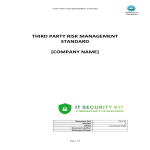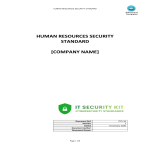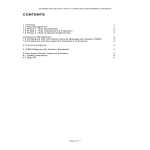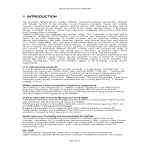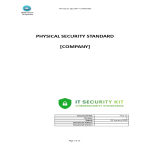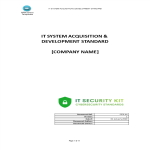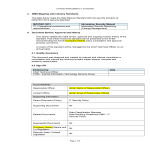Compliance Page 2 templates
Compliance, in general, means conforming to a rule, such as a specification, directive, law, policy, or standard. Regulatory compliance describes the goal that organizations aspire to achieve in their efforts to ensure that they are aware of and take steps to comply with relevant laws, policies, and regulations.
Due to the increasing number of regulations and need for operational transparency, organizations are increasingly adopting the use of consolidated and harmonized sets of compliance controls.[2] This approach is used to ensure that all necessary governance requirements can be met without the unnecessary duplication of effort and activity from resources. Some organizations keep compliance data—all data belonging or pertaining to the enterprise or included in the law, which can be used for the purpose of implementing or validating compliance—in a separate store for meeting reporting requirements. Compliance software is increasingly being implemented to help companies manage their compliance data more efficiently. This store may include calculations, data transfers, and audit trails. On our website you can find several kinds of laws, directives or standards that organizations can comply with, such as: the EU General Data Protection Regulation (GDPR), the California Consumer Privacy Act (CCPA), Cybersecurity standards, ISO 27001, DFARS (Defense Federal Acquisition Regulation Supplement), AVG, DoD, Federal Information Security Management Act (FISMA), Health Insurance Portability and Accountability Act (HIPAA), ISO 22301, ISO 22301:2012 IEC 27001,ISO/IEC 27001:2005, NEN ISO 27001, BS 7799-2, ISO/IEC 27031, ISO/IEC 27032, ISO/IEC 27701, NIST Cybersecurity Framework (CSF), etc.If you didn't start yet, you can find several plans on how to start implementing the necessary measures. We provide tools to help you become compliant.
We provide example Compliance document templates, that are easy to customize to your organization’s specific needs.
-
Secure Algorithm List IT Security Standard
How to create a Secure Algorithm List for IT organization? Download this Secure Algorithm List if you are working on IEC, NIST, ISO27001:2013 cybersecurity.
View template -
Third Party Risk Management Standard
How to create a Third-Party Risk Management Standard for your IT organization? Download this Third-Party Risk Management if you are working on IEC, NIST, ISO270
View template -
Human Resources IT Cybersecurity Standard
How to create a Human Resources IT Cybersecurity Standard for your company? Download this HR IT Security Standard model if you are working on IEC, NIST, ISO2700
View template -
IT Security Risk & Compliance Management
How to create an Information Security Risk and Compliance Management Standard? Download this IT Information Security Risk & Compliance Management Standard now.
View template -
Network Security IT Standard
Download this Cybersecurity standard for Network Security if you are working on IEC, NIST, ISO27001:2013 or other IT and Cyber Security Standards and controls
View template -
Physical Security IT Standard
How to create a Physical Security Standard for IT Assets? Download this Physical IT Security if you are working on IEC, NIST, ISO27001:2013, or other IT and Cyb
View template -
IT System Acquisition & Development
How to create an IT System Acquisition & Development Standard? Download this IT System Acquisition Standard if you are working on IEC, NIST, ISO27001:2013, etc
View template -
Change Management IT Cybersecurity Standard
How to create a Change Management CyberSecurity standard for your organization? Download this IT Security Standard now Standards and control objectives
View template -
IT Asset Management Cybersecurity Standard
How to create an IT Asset Management System for your organization? Download this IT Asset Management Standard if you are working on IEC, NIST, ISO27001:2013, or
View template -
Security Incident Management IT Standard
How to create a Security Incident Management Standard for your IT organization? Download this Security Incident Management if you are working on IEC, NIST, ISO2
View template
Latest topics
- Excel Templates
Where do I find templates for Excel? How do I create a template in Excel? Check these editable and printable Excel Templates and download them directly! - GDPR Compliance Templates
What do you need to become GDPR compliant? Are you looking for useful GDPR document templates to make you compliant? All these compliance documents will be available to download instantly... - Google Docs Templates
How to create documents in Google Docs? We provide Google Docs compatible template and these are the reasons why it's useful to work with Google Docs... - IT Security Standards Kit
What are IT Security Standards? Check out our collection of this newly updated IT Security Kit Standard templates, including policies, controls, processes, checklists, procedures and other documents. - Letter Format
How to format a letter? Here is a brief overview of common letter formats and templates in USA and UK and get inspirited immediately!

